by Julia Haythorn | Dec 19, 2017 | Consultations, Our Neighbourhood
Here are the results from the online survey that Westminster Council (“WCC”) instigated to obtain feedback from residents in the pilot area. (Great Titchfield Street, New Cavendish Street, Gosfield Street, Langham Street, Hanson Street, Middleton Place, Riding House Street and Ogle Street).
After examining the results the executive at FitzWest Forum have made the following comments and recommendations to WCC:
- WCC should now proceed to the next stage, which is implementing the pilot permanently with the proviso that a further consultation should take place six months after this happens.
- Many people feel the collection times are too early in the day. Can these be adjusted to, for example, 8.00 a.m. on street?
- Temporary signage could now be made permanent, with the old signs removed. The presence of both signs is still causing confusion. Add more signs where necessary.
- Foley Street was excluded from the pilot by WCC despite running directly through the middle of the pilot area. It would be helpful for consistency and clarity if Foley Street was included in the permanent changes.
- Some residents have highlighted missed or late collections so can we make sure the new collection times are clearly understood by Veolia. And we will encourage residents to report any problems.
All missed collections etc can be reported via ‘Report It’ section on the Westminster website www.westminster.gov.uk/report-it or call 0207 641 2000.
Several residents requested the reinstatement of the large black bins. This has also been raised with the Forum directly by some residents and is the subject of a petition. We have passed on these views to WCC. The background to this is that late in 2015, almost two years before the pilot began, WCC removed almost all the black bins in the pilot area (and beyond) on the grounds that they encouraged dumping around them. WCC told us at that time that the very limited number of bins that remained would only be left if there was a proven need for them. This has remained WCC’s position.
Within this context, the aim of the pilot was to increase frequency and efficiency of collection of rubbish and recycling. Whatever decision WCC reaches with the black bins, our aim at the FitzWest Forum is to continue to support more frequent and efficient rubbish and recycling and to keep reminding WCC to be consistent and efficient with collections and street cleansing.
by Julia Haythorn | Aug 24, 2017 | Consultations, Environment, Our Neighbourhood
Everyone in Fitzrovia has noticed the rubbish and dumping that unfortunately seems to have become a daily blight on our streets.
One of the significant problems identified by residents is that there is a general confusion on collection times and days and signage is inconsistent with what happens in reality. As a result of this confusion many residents have a become accustomed to putting our rubbish out at any time which has led to the rubbish-strewn streets. Also there has been a more general call for the number of recycling collections to be increased.
The Fitzrovia West Neighbourhood Forum, in consultation with local residents, has worked with Westminster City Council over the last two years to agree simplifications and improvements to recycling and rubbish collection times. These are now being trialled in a limited area of Fitzrovia as part of the pilot. A map of the pilot area is below.
The pilot improves and simplifies the collection arrangements, including an increase in recycling for all streets and an increase in rubbish collection in some streets. Our area is fortunate, unlike our neighbours Camden and other London Boroughs where refuse and recycling is often only once a week (with reviews in hand to move this back to fortnightly) we will see an increase in general and recycling collection.
It is acknowledged that restaurants and businesses contribute to the rubbish problem and they also have been informed of new collection times in order to reduce the amount of time rubbish sacks are on the streets.
People have complained about dumping, especially by builders and house clearers. Westminster hopes to place more officers on the street during the pilot period, to enforce this and other contraventions.
As a part of the Neighbourhood Forum, we as residents and local businesses can all work together for the greater good of our environment. We do want to make sure that all residents understand the pilot arrangements and the new and improved collection times and days. The Council is contacting all households to explain the new arrangements first and providing letters to identify collection times in the particular streets in the pilot area.
We are all looking forward to seeing cleaner streets as the pilot progresses.
We would very much like to hear residents’ feedback to the pilot and the improvements to the service.
Please comment below or contact us by email at info@fitzwest.org. Feedback can also be provided to Tom Walsh at Westminster City Council His email address is:
twalsh@westminster.gov.uk
Details of the pilot
From Monday 4th September 2017 please put out your recycling and rubbish for collection at the following times:
Please leave your tied recycling and rubbish directly outside your property for collection. Apart from pedestrianised streets such as Middleton Place rubbish and recycling is not to be piled up at the ends of streets.
Please do not leave recycling and rubbish out on the street outside of these times or overnight. This is considered to be fly tipping and you could be fined by Westminster Council. It also encourages seagulls, pigeons, rats, mice and other vermin.
How to put out your recycling and rubbish:
For recycled waste please use the clear recycling bags provided by Westminster City Council. You can order recycling bags online via: westminster.gov.uk/recycling-bags
Please put your normal rubbish out in appropriately tied bags, such as black bin bags.
Look for the new signs on your street for exact timings.
Bulky waste collections
For items such as fridges, mattresses and tables, etc., please arrange online via:westminster.gov.uk/residential-bulky-waste Please be aware that leaving bulky waste items on street is illegal and can lead to substantial fines. Feedback from our consultation reveals that many residents consider this to be a major anti-social issue. The Council will be inspecting streets to enforce against illegal street dumping.
For further information about Westminster City Council’s waste services, please visit: www.westminster.gov.uk/recycling.
Comments
Please do let your neighbours know about these important changes and please look at your local street notices. The pilot is being arrnaged by WCC and they are responsible for the details.
Working together we can improve our streets; stop fly-tipping and street dumping and reduce the amount of rubbish left on the streets. The increase in recycling provision will also help the environment.
Please comment below or contact us by email at info@fitzwest.org. Feedback can also be provided to Tom Walsh at Westminster City Council His email address is: twalsh@westminster.gov.uk Because of holidays please bear with us if you do not see your feedback here for a few days. Rest assured we will be monitoring daily after 5th September.

by Julia Haythorn | Mar 31, 2017 | Consultations, Environment, Our Neighbourhood
Westminster City Council has launched a wide-ranging public consultation to identify the best way forward to manage the future growth of Westminster entitled, ‘Building height: Getting the right kind of growth for Westminster is seeking the views of all those that live, work and visit the City.’
The feedback received during the course of the consultation, which will run for eight weeks, will help inform Westminster City Council’s future plans for the City which will be set out during the statutory consultation on the City Plan later this year. As part of this consultation there will be a series of public events taking place across the City.
There is a questionnaire on the internet which we encourage members and friends to complete.
Here is FitzWest response to the consultation:
Dear Sirs,
Thank you for giving us the opportunity to respond to your consultation regarding building heights. We welcome the fact that you publish a wide ranging consultation before bringing out a draft policy.
- We do not think that Fitzrovia, in fact any part of the Central Activities Zone, can or should be expected to support major growth in heights or bulk.
- We consider it a fallacy to suggest that economic growth goes hand in hand with increased density and/or height.
- In fact we consider the opposite is true – that small businesses are the life-blood of the central London economy and would only be damaged by whole scale redevelopment or intensification.
- We should seek an intensification of quality not quantity.
- We should respect the height, scale and massing of the conservation areas.
- We should respect the amenity and qualities of living that current business and residents possess. It should not be made worse by bulky overshadowing buildings.
- That the complexity of servicing and managing such diverse uses as exist here is already beyond the capacity of Westminster City Council (in their current economic travails) and that no intensification should be considered, because it is not serviceable.
- That high rise buildings are not environmentally sustainable.
The premise that growth and tall buildings are one and the same
Economic growth is often equated to growth in construction or density. Yet in the centre of a capital city there is no evidence to suggest that this is so. In fact cities like Bangkok, that have undergone uncontrolled growth in recent years, have seen a dramatic fall in economic activity as environmental quality has plummeted. What happens is that instead of the city thriving, it starts to die. People decide to re-locate to greener and more pleasant suburbs.(i)
Westminster, being located almost entirely in the Central Activities Zone, should not be seen as a place for construction growth, but instead as a place for economic growth. Economic growth will not occur if Westminster becomes overcrowded with unnecessarily tall and over-bulky buildings.

Pollution in Bangkok Source Bangkokscoop.com
Function of the Central Activities Zone (CAZ) and its Core
The Core CAZ, in general and Fitzrovia in particular, are areas of extraordinary diversity. Planning policy tends to have seen the Core CAZ as simply a retail hub. It is not now and given the rise in internet shopping, it is unlikely to become so in the foreseeable future.
It is this diversity that contributes to the economic dynamism of The City of Westminster and to London as a whole. The diversity includes institutions, educational establishments, smaller offices, hi-tech businesses, residential, specialist retail and cafes. Most of these uses would leave if the area were redeveloped to a larger scale.
Westminster’s own study (ii) indicate that a majority of Westminster’s businesses are small businesses, with 85% of VAT registered businesses having less than ten employees (IDBR, 2010). These small businesses are the life-blood of Fitzrovia.
The Centre for Cities states in a recent report;
Small firms trading with other firms in London, nationally and internationally (small B2B firms), are concentrated in two areas: London’s core and to the west, near Heathrow and national motorway links. These firms account for just 18 per cent of all London’s small firms but have the greatest potential to make a significant contribution to future jobs growth. (iii)
A growth policy should be aimed at retaining and supporting this cohort of small businesses. They do not require tall buildings, or large floor-plates. In fact, such businesses rarely locate to new buildings, which they cannot afford. They are far more likely to seek space within the buildings that Fitzrovia already possesses. They locate to be near one-another – so redevelopment has a negative effect in forcing out small business and bringing into the area larger, less economically dynamic business.
In most cities large floor-plate and high rise offices are located on the outskirts and useful transport hubs. Compare Montparnasse in Paris and Paddington in Westminster.
Tottenham Court Road (within Westminster and within Fitzrovia) is not a tabula rasa. Its is not a blank canvas onto which high-rise can or should be foisted. It is in fact one of the most historic parts of the City of Westminster, being very ancient indeed and thus should be a candidate for conservation, not annihilation.
Housing in Fitzrovia
There may be some individual sites, on the boundaries of Fitzrovia where higher rise housing is relevant and can be built to redress the gathering imbalance of housing types and tenures in our city centre. We have identified sites in our emerging Neighbourhood Plan. But because there is densely packed housing here already the capacity of sites to come forward that would not overshadow and over-bear existing dwelling is extremely limited.
The population of Westminster is said by Westminster City Council to have been underestimated at the last census by 10%. It is not satisfactory to say (as has been argued in recent planning applications) that people who live in the centre of a city should put up with increasing density, even if their habitable windows are obliterated from daylight.
Conservation Areas
The majority of Fitzrovia West (and in fact the whole of the central core) is located within a series of conservation areas. It already has a very high residential population, made higher by the inclusion of a very rich mix of activities. The general building height of 60ft in residential buildings and 80ft in ‘factories’, which comes from the London Building Acts of the 1880s and 90s, is still valid in this area and should not be compromised.

View across the rooftops of Great Titchfield Street looking towards Soho and Mayfair. The consistency of roof-line is remarkable.
Most historic urban centres have a cap to heights. Oxford is one example. Paris is another. Westminster should have its own height cap. This should not be seen as a restriction to growth, but in fact one of the reasons why the historic centre will always be more attractive than the outskirts. Dynamic, highly profitable, discerning businesses wish to locate here.
Access
The perceived wisdom is that areas of high public transport provision should be the location of high-rise. That is how Centre Point received planning permission originally. But in Central London that logic is wrong. It is a fallacy, because it assumes that there is capacity on the ground already. But in Central London we would question whether the imminent improvements in public transport are not simply running to catch up. That the new Cross Rail stations, balanced by reduction in private car trips and bus services may only just cover the current needs, let alone natural growth. What evidence do we have that such systems will have capacity to support major growth in residential or working populations in the centre?
In addition there is already a lack of cycle parking and disabled parking. How could large intensive uses occasioned by high rise be supported unless there was large areas of cycle parking and disabled parking around them?
The Servicing of Taller Buildings
The consultation paper does not consider the servicing of taller buildings. The centre of Westminster can not cope with the servicing it already has. Rubbish collection, deliveries and street cleaning have all failed in this area. The level of vermin and mess is embarrassing.
Servicing of tall buildings requires far more hinterland and larger carriageways than is possible in Fitzrovia. It requires large service bays and a regular stream of heavy vehicles. We do not think it is appropriate in central London and in Fitzrovia in particular where the densities are already extremely high.
Emergency Servicing
Since the Kings Cross disaster, when the fire brigade is called in Fitzrovia, regardless of the scale of the fire, four fire engines turn up, from two different locations. That is because of the impossibility of ensuring a traffic free access for emergency vehicles. Yet the potential for emergency access to larger buildings is never considered in planning policy. It is taken for granted that the city can cope. We don’t think that Fitzrovia (or other parts of the core CAZ) can cope. Any further increase in the critical mass of servicing in this part of the centre of London is not sustainable. This has impacts on the pleasantness of our streets but in these times of terrorism could contribute to a major disaster if left unresolved.
Environmentally Sustainability
High rise buildings are expensive to heat, cool and service. They use powered systems that are alien to the essentially Georgian structure of our current city, that does not need gas guzzling, air conditioning or complex heating systems. Any increase in carbon emissions or heat supply from building exhausts will turn an already polluted area into a danger zone. Unless a large building can show a reduction in such impacts it should not be considered.
Greening
There is a suggestion that a few extra floors on any building might be tolerable. But we would maintain that the flat rooves of many of the buildings in this area should be used as amenity space. That means planted and accessible roofs. Modest increases may be acceptable if such an increase provides much needed public or semi-public amenity space.
i) ‘The increasing density of population (due to population growth and migration) and disorderly urban settlements and together with the rapid economic development have brought an exceeding demand of infrastructure, public utilities and public services, which is unfortunately beyond the capacity of the Bangkok Metropolitan Administration (BMA), the city administration of Bangkok, to handle alone. This results in the deterioration of urban environment, urban services and also urban quality of life.’ Report by Suganya Boonprasirt, Policy and Planning Department, Bangkok Metropolitan Administration, City Hall of Bangkok Metropolis. http://www.gef.or.jp/20club/E/bangkok.htm
ii) Westminster’s Economy Developing Westminster’s City Plan, file:///C:/Users/Wendy%20Shillam/Downloads/westminster’s%20economy%20CM%20Version1.pdf
iii) The Centre for Cities, Size matters: The importance of small firms in London’s economy Rachel Smith, Dmitry Sivaev and Paul Swinney December 2012 ize matters: The importance of small firms in London’s economy Rachel Smith, Dmitry Sivaev and Paul Swinney December

by Julia Haythorn | Apr 9, 2016 | Consultations, Our Neighbourhood, Public Space

The forum receives more complaints about rubbish than almost any other topic. In response to this we have set up a sub-group to focus of the problems of rubbish disposal, dumping and collections in our area.
We’ve devised a questionnaire and we would be very grateful if you could fill it in for us, giving us your views.
https://docs.google.com/forms/d/190rmWoVZjnJ-8IuVYafRcta49kBJ-22QpS7v99ycEWE/viewform
If you have any further comments please feel free to add them in the comments box below, or if you are reading this on our home page use the quotation icon at the head of this article.
Thank you.
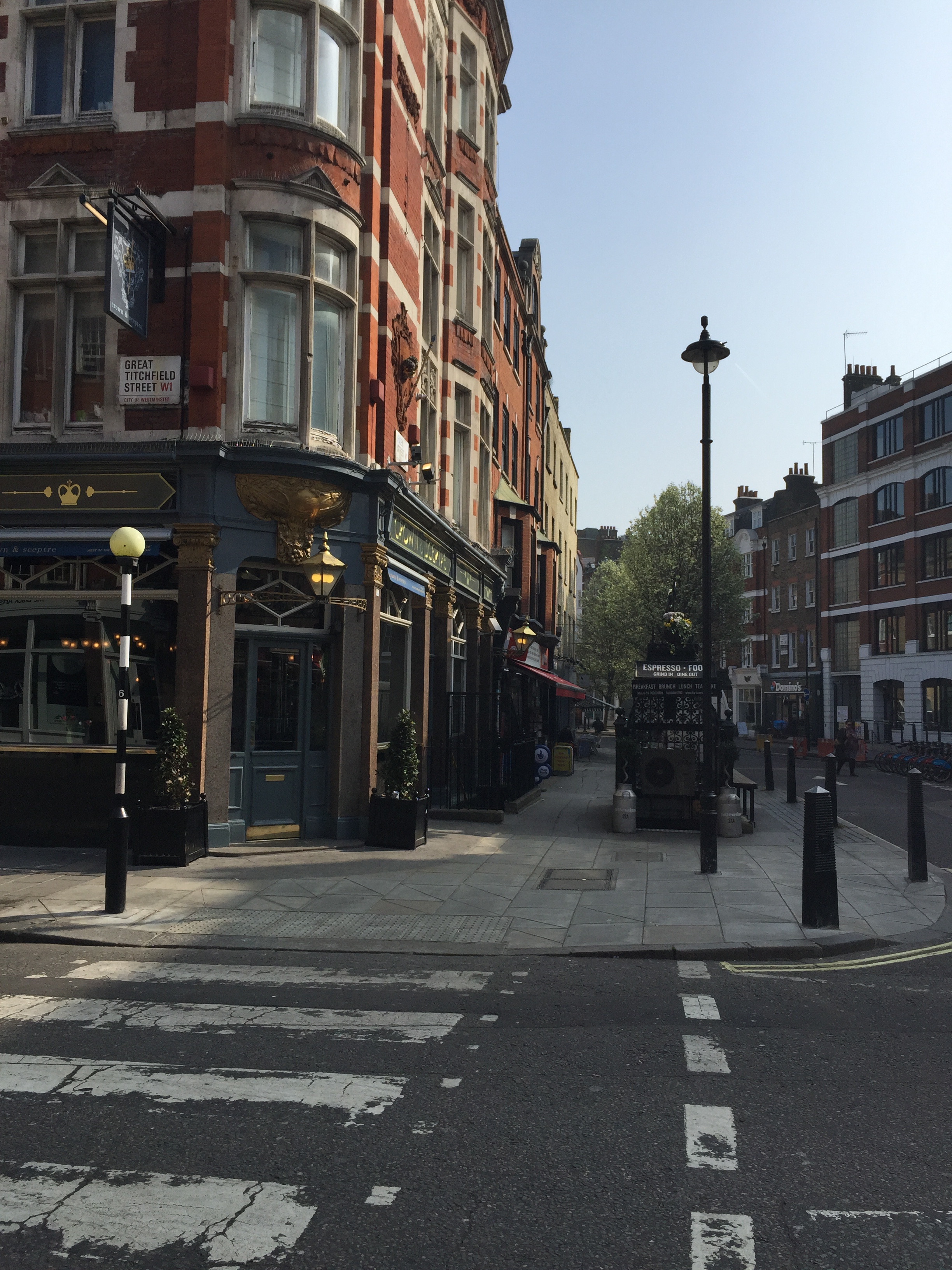
by Julia Haythorn | Dec 6, 2015 | Our Neighbourhood
Printed also in Fitzrovia News
Fitzrovia West Neighbourhood Forum (FitzWest) will be holding a public exhibition and consultation entitled FitzWest Futures – Have Your Say at the Getty Gallery, 46 Eastcastle Street, London W1W 8DX from 11.00am – 8.00pm on Monday 11thh January. This will be an opportunity for people to see the progress we’ve made with the FitzWest Plan and give their views. In anticipation of this event, I’ve been garnering my own thoughts about the area. I’m using this month’s article to highlight public space.
All of us city dwellers tend to live our lives much more in the public domain, in the streets, cafes and public spaces of our neighbourhood. My twenty four hour diary gives a glimpse of how I use our streets, not only as a thoroughfare, but as a breathing space and a meeting place.
3.00pm Tuesday
I bump into a friend. We decide to sit on one of the benches under the trees in Candover Street for a five minute catch up. It could be a lovely spot, but the parking, the rubbish bins and cars screeching round the corner detract from its potential. A shame, because Candover Street possesses some of our finest arts and crafts buildings in central London, including Boulting’s Manufactory (1903 by the architect H Fuller Clark). But if I were to step back to admire the architecture, I’d probably be run down! The speed limit in our area is 30mph. Should it be less?
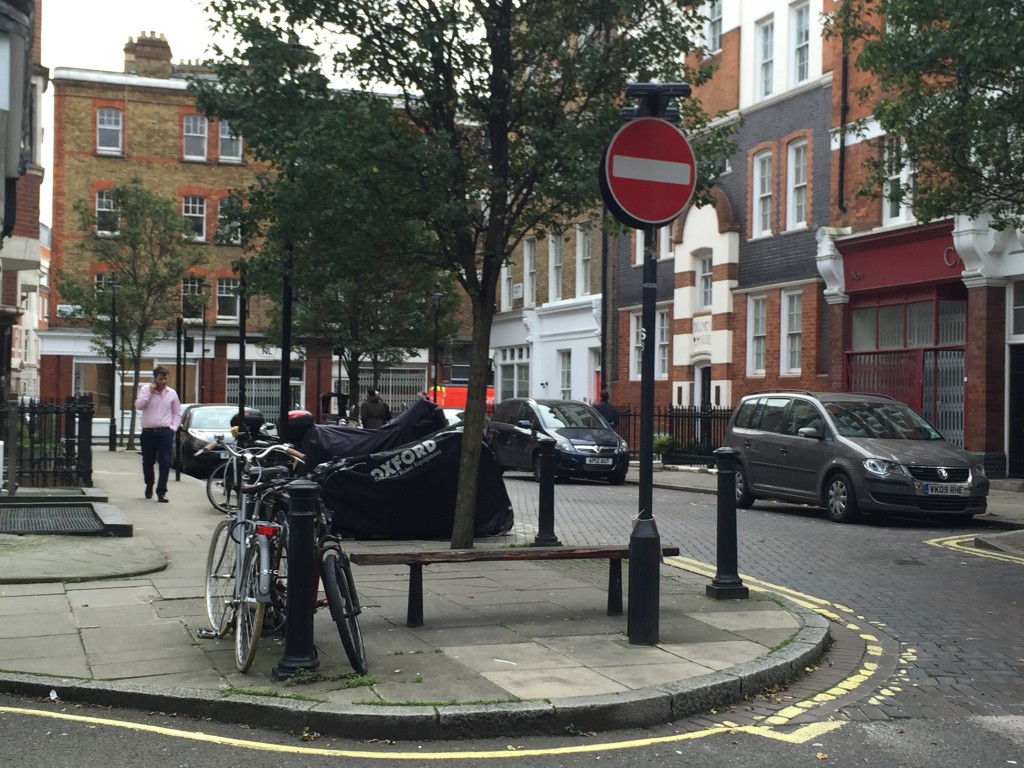
Later:
I’m off to the Yorkshire Grey for a quiet pint with my husband. We plan to sit on the benches in Nottingham Place, but this building, like hundreds of others in our area is having a refit, so instead of a quiet corner we have builders’ mayhem. We walk around into Riding House Street which is also full of builders gear and completely blocked off to cars. I reckon the street cleaners have abandoned it too.
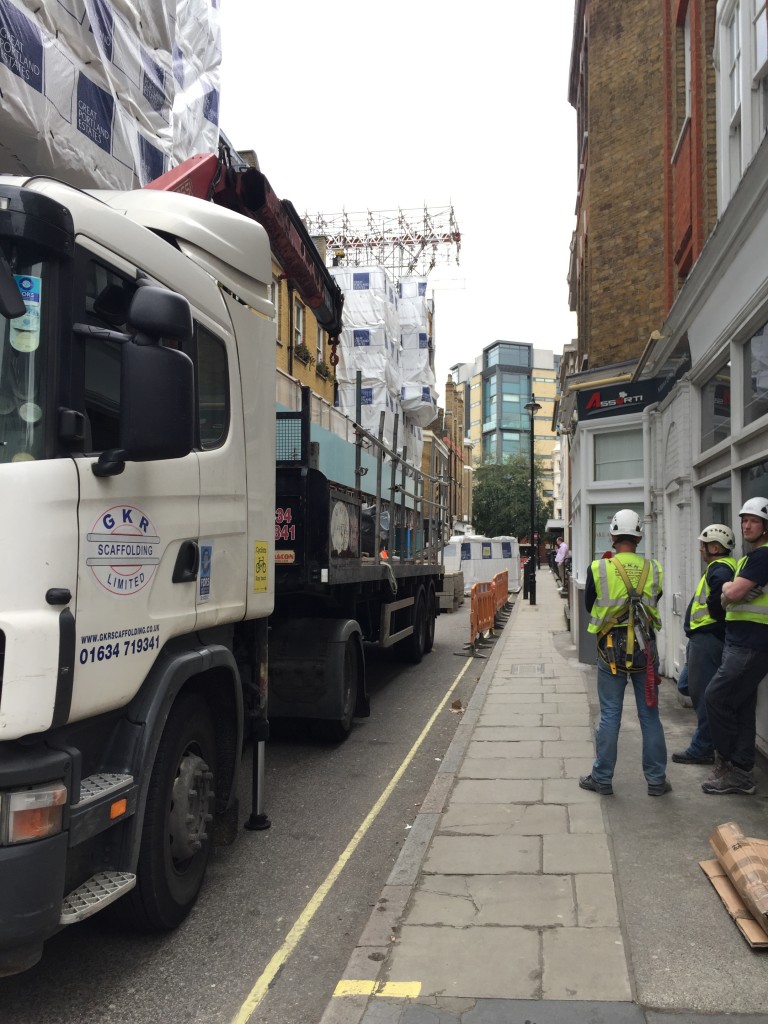
1.00am Wednesday morning
I’m woken by shouts in the street. An arguing couple probably don’t realise that I’m in bed only a few metres from where their voices are becoming increasingly raised. I pull the curtains aside. There they are, under the lamp post, oblivious to the fact that all my neighbours can hear them. About 4,000 people live in FitzWest. It is actually one of the most densely populated neighbourhoods in the country.
10.30am Wednesday
I’m cycling off to do some shopping. New Cavendish Street is to be designated as a cycling quietway, but who knows how they’ll manage it. I take my life in my hands, it is so congested. I think we need quiet quarters, not just a few so-called quiet streets. Are any of the through routes really necessary in FitzWest?
Some of my neighbours are still putting out rubbish, oblivious of the fact that the collection is long gone and they are all potentially in line for a £50.00 fine. I’m disgusted when I see two open bags full of food scraps that will undoubtedly attract vermin. But to give them their due, collections are not advertised on my street. Many people would prefer to take their rubbish to a recycling point.
Turning into Langham Street I have to negotiate another hazard. The female Ginko trees have dropped their fruit. The council have made an attempt to clean up the pavement, but it still smells disgusting. My heel slips on gunge.
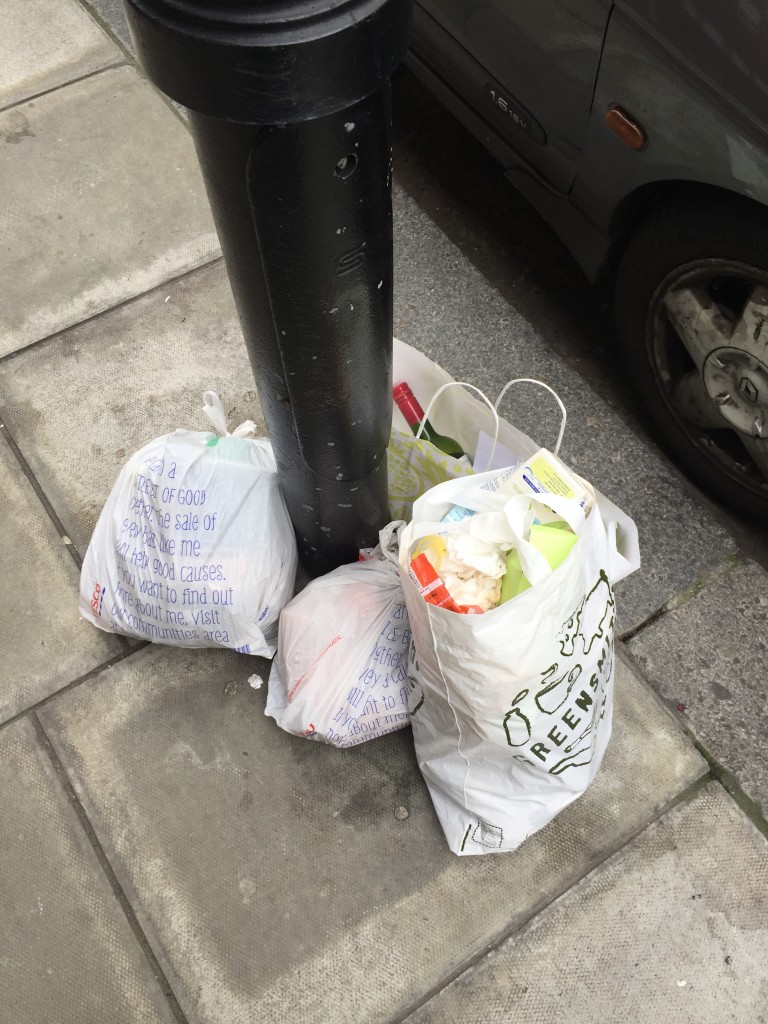
1.00pm Lunch in a cafe
We all value this area because of the cafes and cosy pubs. I love the independent shops, the quirky businesses, the galleries and college activity. But the traffic, noise, pollution and rubbish nuisance that this intensity of use causes is something we hate. This is a beautiful area with huge potential. I ought to be proud of living and working at the heart of this great city; not embarrassed by the mess.
The FitzWest Forum is taking some short term action. We’ve asked for the Ginko trees to be replaced. We’ve started a dialogue with Westminster City Council, trying to find solutions to the rubbish problem and we’ve joined with The West End partnership to see if we can make change right across the West End.
Then there are the invisible menaces. Noise is one; pollution another. The invisible pollutants like nitrogen dioxide and fine particulates are more pernicious than ever the London smog was. They are at their greatest intensity in our area, Euston Road, Marylebone Road and Oxford Street are hotspots. More than 10,000 people die each year in London from pollution (GLA figures). It affects the young and the elderly disproportionately. Calming the traffic and planting would help, but really we must consider restricting air conditioning and discouraging diesel vehicle trips.
In our last public meeting the forum made public space issues one of the top priorities for the FitzWest Neighbourhood Plan. In the January exhibition at the Getty Photographic Gallery, we will be proposing new local planning policies can support this ambition.
Have your say. It’s free to join the forum here: Fitzwest.org/wordpress
By Wendy Shillam Chair of FitzWest
An edited version of this article appearsin the December 2015 issue of The Fitzrovia News

by Julia Haythorn | Nov 2, 2015 | Environment, Our Neighbourhood, Public Space, The Plan
This week I have been thinking about the environmental benefit of roof gardens and edible gardens in particular. My thoughts have been driven by two very different events. The first is that the West End Partnership have been adding flesh to the bones of their plans for London’s West End. As a member of their Peoples Task Group, I needed to consider, among other topics, what their emerging greening strategies might mean for people who work here, live here or visit Fitzrovia.
And in another, completely unconnected event, my own rooftop garden features in this month’s Garden Magazine, the organ of the Royal Horticultural Society(RHS). It is a special issue devoted to urban gardens.
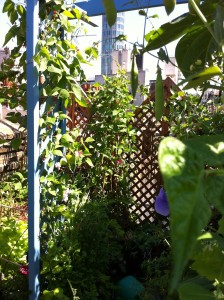
My own rooftopvegplot. Open by appointment April – September
If you are not a member of the RHS then this might be a good time to join. The organisation is slowly becoming a little more progressive and organic gardening, protection of wildlife and greening the urban realm are now all on their agenda. People like me, who do not own acres of manicured evergreens somewhere in the Dukeries, are now welcomed. I’m rather proud that a productive, urban, organic garden, the size of a postage stamp is featured within the hallowed pages.
The RHS is taking a number of excellent initiatives that the most progressive of urban gardeners and the most devoted of environmentalists would approve. In this issue November 2015, the magazine is suggesting how we can find space and place to plant more. Their ‘Greening Grey Britain’ initiative.
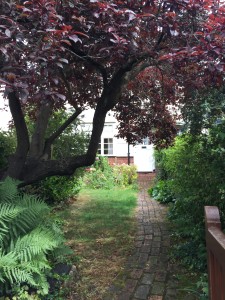
Front gardens make an amazing difference. But we don’t have front gardens in the inner city!
The RHS are right on the button when they say that gardens play a crucial role in urban and suburban areas, and potentially will become even more important in the future as our climate changes. From helping protect us against flooding and extremes of temperature, to supporting wildlife and helping gardeners to be healthy, gardens can provide an amazing range of benefits.
https://www.rhs.org.uk/science/gardening-in-a-changing-world/Greening-Grey-Britain/urban-planting
The estimate is that 25% of the urban realm is open space, that might be transformed into a garden. That could be a formal flower garden, a wild space, a flowering place for pollinators or an allotment. Gardens can be at ground level, on balconies or on rooftops. Temporary gardens can be found on building sites. So called guerrilla gardens can spring up anywhere. We have our own guerrilla gardens in Great Titchfield Street, started by one of the flat dwellers in Collingwood House. The idea has proved infectious, the space around trees in the street have been invaded by flowers right up as far as the restaurant Conchiglia and the Smile Clinic. Well done to those businesses for taking up the initiative. It’s a great pleasure to walk down that part of the street now. (Though I despair at the number of cigarette butts I see casually tossed into flower beds.)
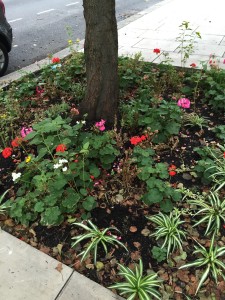
Guerrilla Gardening in Great Titchfield Street
My own contribution to greening the city is a rooftop vegetable plot, designed to be intensively productive all year round as well as beautiful. It is organic, and full of flowering produce as well as leaves and roots. I have bee hotels up there, a stick tower for insects and several bird feeders and nesting boxes. You can find the article in this month’s RHS magazine, or in the recently published book, ‘My Tiny Veg Plot’ by Lia Leendertz. Pavillion, Books 2015. This lavishly illustrated book is an excellent resource for different urban/small space gardening techniques.
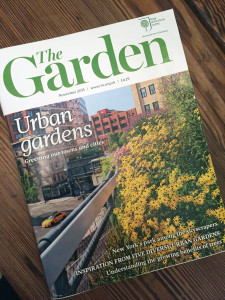
As part of the FitzWest Neighbourhood Plan we will be looking at how we can improve the urban space. That’s about reducing deliveries, traffic calming and improving space for pedestrians and cycles. It’s about improving our rubbish collection system so that the streets are no longer strewn with take-away cartons and banana skins. It’s about management of contractors and street diggers, so that builders rubble, skips and cranes don’t litter the streets, causing danger to pedestrians and blocking carriageways. And it’s also about finding more places for planting.
A survey of green space in FitzEast has already been completed for the Business Improvement District. This is an issue that touches those who work or visit the area as much as it does residents. We need something similar in FitzWest.
if you would like to join FitzWest please visit this page of the website:
https://fitzwest.org/become-a-member/
And if you’d like to help with the survey of public space and greening of FitzWest email me, Wendy Shillam on info@fitzwest.org













